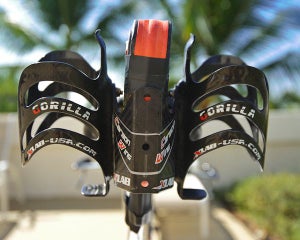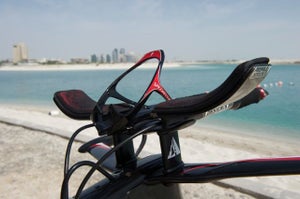Ask Aaron: Race-Day Gear Adjustments
In today’s “Ask Aaron” column Aaron answers questions about making gear adjustments for race day. He provides advice on what spare tire equipment to carry, what water bottle setup to use and how to best make fit adjustments based on the distance of the race. Click here to view past “Ask Aaron” columns.
Q. Hello Aaron,

Curious about your thoughts as to when I should worry about carrying a spare tubular tire, CO2, lever, blade, etc. at triathlon events. Does the distance matter?
─Harry
A. Harry,
I think you should carry a spare tubular in any race that you would rather finish five minutes slower than not finish all-together.
Once you have practiced changing a tubular tire a few times, it really isn’t that time consuming and, in fact, can be faster than changing a clincher. To ensure a quick and safe tire change on the road, make sure your spare tire has been pre-stretched and pre-glued before the race. To stretch the tire, mount it onto a rim and inflate it without gluing it to the rim. Let it sit for at least 24 hours. This allows the tire casing and base tape—the structural parts of the tire—to stretch slightly and will make it much easier to mount the tire on the rim. If the tire hasn’t been pre-stretched, it could be very difficult to muscle it onto the tire during the race. After stretching it, take your spare and apply a layer of glue to the base tape and allow it to dry. This will allow the tire to stick slightly to the rim if you have to mount it during a race. Be careful when cornering, however, because the tire will not be properly adhered to the rim and could roll off the wheel if you corner too aggressively.
Regardless of the race distance, I always bring a canister of Vittoria Pitstop when I race on tubular wheels. Pitstop is a combination CO2 cartridge and tire sealant that fixes most small punctures are simultaneously re-inflates the tire to about 80-90 psi. It is always my first line of defense against a flat tubular tire.
─Aaron
Q. Hi Aaron,
I rode Ironman UK last year on a PlantX stealth TT with pretty much full stack on the bar height to make sure my back survived for the impending run. I’ve dropped down race distance this year and will only be doing Olympic and the half iron-distance, so I have reduced the stack height to a minimum. I have now noticed a power drop since adopting this new position, circa 10-20W over a 20-minute hard session. As I do not have access to wind tunnel to confirm the aero benefits of this new position, how would you best advise I determine optimum ride position/angle, as the obvious go and ride a repeated route has too many variables for me to determine robustly (i.e., fatigue, wind, nutrition etc).
─Steve
A. Steve,
Balancing watts lost to an aggressive position with aerodynamic efficiency gained with that position can help a time trial cyclist find the fastest configuration, but that equation doesn’t take into account the fact that you, as a triathlete, have to run off the bike. Nor does that equation factor in the amount of time you will be twisted into a position that is difficult for you to hold. Perhaps you loose 10-20 watts over 20 minutes, but how much are you losing over the final 30km of a half-Ironman cycling leg? I think the best solution is to find the most aggressive position that you can comfortably hold.
As your torso gets lower and lower, your hip angle get more acute, which eventually restricts the function of your hamstrings, lower back and the muscles crossing your hip joint—glutes, TFL, hip flexors. It often manifests itself with a pinched feeling on the front of your hips. The beauty of triathlon-specific geometry is that it allows you to ride in an aerodynamic position with nearly zero power lost, but there is a limit to the drop your body can handle, even on a triathlon bike. Going from the highest orientation to the lowest on your bike was evidently too extreme a change for your body to tolerate. Rather than going from one extreme to another, try lowering yourself a single centimeter at a time and then riding that position for several weeks. Even a small change can create some of the problems you have experienced, but your body can sometimes adapt to the new position and become comfortable over time. It usually takes me about four weeks to get completely accustomed to a new position. Once you feel at home with the lower aerobar setup, drop them another centimeter and go through the same process. Eventually, you will find an aerobar height that is simply too low for your body to adopt and you will not be comfortable, even after an extended adaption period. When that happens, you’ll have hit your limit. At that point, go back up to your lowest comfortable position and stick with that one until you start experiencing discomfort again, or get a professional bike fit. I found that the pigeon pose, commonly used in yoga practice, helps me get comfortable in an aggressive position on the bike.
─Aaron
Q. Hello Aaron,

What is in your opinion the best way to carry water bottles for the Ironman and 70.3 distance? Like Chris Lieto with a Bontrager aerobottle between the aerobars or like Chris McCormack with some sort of lollypop between the aerobars?
─Kees
A. Kees,
There are three different common styles of hydration accessory used by pros and age-groupers alike.
1. Water bottle cages on the frame. They come in two styles. Traditional cages, of course, hold standard round bottles and a few companies produce aerodynamically shaped frame bottles that cannot be swapped at an aid station.
2. Between the aerobars. Bottles mounted between the aerobars are popular because they are easy to access. Again, you can choose an option that can hold a standard bottle–like the one Macca uses–or one that allows you to drink from on the go and can be refilled by pouring more drink into it.
3. Behind the saddle. These contraptions can carry up to three round bottles and some also have room for flat repair supplies.
The most important thing when choosing a hydration system for long course racing is to make sure you have at least one cage that can hold a standard bottle you grab from an aid station. Even if you are going to refill a between-the-bars system, it helps to be able to take a bottle on while waiting for a good chance to refill that container. Once that need is met, choose based on your comfort drinking from the system. If you are more inclined to drink more if you have a straw in your face to remind you, bring a between-the-bars bottle. If you are comfortable reaching behind to grab a bottle from a rear hydration carrier, that works as well. I personally like to carry a refillable drink system between my aerobars and round bottles on the frame.
─Aaron